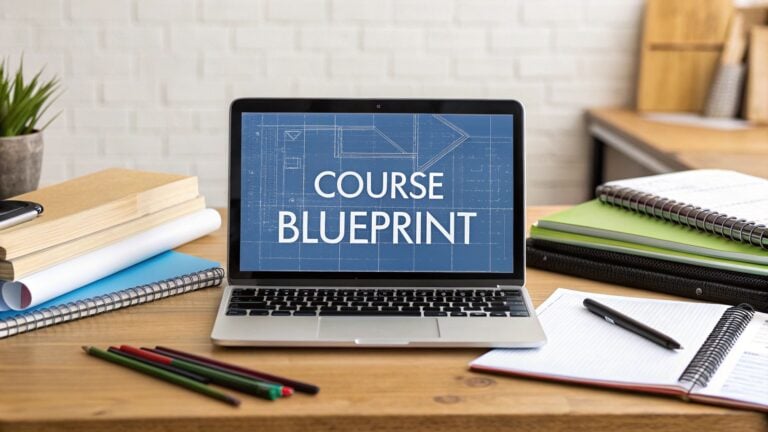How to structure a webinar? A Beginner’s Guide

Hosting a webinar that grabs attention and makes a strong impression is very important. This guide will help you understand how to plan and run your webinar well.
- Preparing before your webinar starts
- Arranging your webinar’s content to keep people interested
- Ways to encourage your audience to participate
- What to do after your webinar ends
Pre-Webinar Planning
Before you start your webinar, you need to prepare well to make it successful. Here’s how you can plan:
Understand Your Audience
- Find out what your audience needs and what challenges they face.
- Make your webinar meet their specific needs.
- Think about how much they already know about your topic.
Pick a Good Topic
- Choose a topic that shows your knowledge and meets the needs of your audience.
- Create a title that is interesting and explains the benefit of your webinar.
- Make sure your topic is specific and can be discussed fully in the time you have.
Set Goals
- Decide what you want your webinar to achieve (like teaching something, getting more customers, or presenting a product).
- Make goals that you can measure to see if your webinar is successful.
- Make sure your content and the actions you ask your audience to take match your goals.
Choose the Right Tool
- Look at different webinar tools to find one that fits your budget and needs.
- Check for features like ways to interact, recording options, and how easy it is to use.
- Try the tool before your webinar to prevent any problems during your presentation.
III. Webinar Content Structure
To keep your audience interested from the beginning to the end of your webinar, you need to organize your content well. Here is a simple structure to use:
Engaging Introduction
- Begin with a friendly greeting and introduce yourself quickly.
- Explain the main benefits and what attendees will learn from the webinar.
- Outline what will be discussed in the webinar.
Compelling Core Content
- Divide your main topic into smaller, easy-to-understand parts.
- Share stories, real examples, and studies to make your points clear.
- Use visuals like slides, videos, or live demos to help explain your ideas.
- Get your audience involved by using polls, Q&A sessions, and chat features.
Strong Conclusion
- Recap the main points and what attendees should take away from the webinar.
- Offer extra materials like handouts or links for more information.
- End with a specific action you want attendees to take, like signing up for a product or joining a group.
- Thank your audience for joining and spending their time.
Using this content structure will keep your audience focused, informed, and ready to act.
IV. Engagement Strategies
Keeping your audience engaged throughout the webinar is crucial. Here are some strategies:
Encourage Interaction
- Start with a simple question or poll to get people involved.
- Use chat to encourage questions and feedback.
- Ask attendees to share their own stories or thoughts on the topic.
Use Moderators
- Have a co-host or moderator to help manage the chat and handle any issues.
- Let the moderator organize questions for the Q&A.
- Make sure the moderator keeps the conversation relevant and follows the rules.
Make It Fun
- Add quizzes, challenges, or contests to keep things interesting.
- Offer rewards or bonuses for taking part, like downloads or discount codes.
- Recognize active participants with a leaderboard or mentions.
Help People Connect
- Give chances for attendees to meet each other, using breakout rooms or group tasks.
- Encourage sharing of contact details or social media profiles.
- Arrange for further networking after the webinar through follow-up emails or online groups.
These strategies will make your webinar more lively and memorable.
V. Post-Webinar Follow-up
The work doesn’t stop when your webinar ends. Following up is key to reinforce your message and build relationships. Here’s what to do:
Share the Recording and Resources
- Give attendees the webinar recording and any materials promised.
- Send an email with links to the recording, slides, and extra resources.
- Post the recording on your website or social media for those who missed the live session.
Get Feedback
- Ask attendees for their thoughts on the webinar through a survey.
- Use their feedback to improve future webinars and adjust your content to better fit your audience.
- Look at how many people attended, how they participated, and if they took any action afterwards.
Nurture Leads
- Group your attendees by how interested they seemed or how they interacted.
- Create targeted follow-up messages to encourage them through your sales process.
- Offer personalized resources, demos, or meetings to help them take the next step.
Stay in Touch
- Invite attendees to join your email list or follow you on social media.
- Keep sharing useful information and updates to keep them engaged with your brand.
- Let them know about upcoming webinars or events.
By focusing on these follow-up actions, you will maximize the impact of your webinar, build stronger connections, and achieve better results for your business.






![How to Effectively Host Webinars Using OBS Studio [Guide from Expert]](https://learnstream.io/wp-content/uploads/2024/08/image-768x333.png)